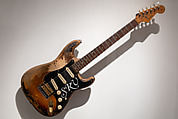On loan to The Met The Met accepts temporary loans of art both for short-term exhibitions and for long-term display in its galleries.
"Number One" composite Stratocaster
Not on view
Stevie Ray Vaughan, one of the key drivers of the 1980s blues revival, used “Number One” as his main instrument throughout his career. Vaughan acquired the Stratocaster, built from a 1963 body with a 1962 neck and 1959 pickups, from Ray Hennig’s Heart of Texas music store in 1974 and modified it with a black pickguard featuring his initials. Inspired by Jimi Hendrix and Otis Rush, Vaughan added a lefty vibrato. Vaughan played this guitar on his albums with Double Trouble and with his brother Jimmie Vaughan, and he likely used it on David Bowie’s Let’s Dance in 1982, made after the two met at the Montreux Jazz Festival.
Technical Description:
Contoured alder body, maple neck, rosewood fingerboard; 25½ in. scale; sunburst finish; bolt-on neck with dot inlays; gold “spaghetti” Fender logo decal on headstock; three single coil pickups, three-way pickup selector, one volume and two tone controls; gold-plated left handed vibrato system, Schaller tuners; constructed from 1963 body, 1962 neck, 1959 pickups, vibrato replaced, black pickguard with SRV initials, all chrome hardware replaced with gold, “custom” decal at bridge, cigarette burn on headstock
Due to rights restrictions, this image cannot be enlarged, viewed at full screen, or downloaded.
This artwork is meant to be viewed from right to left. Scroll left to view more.




